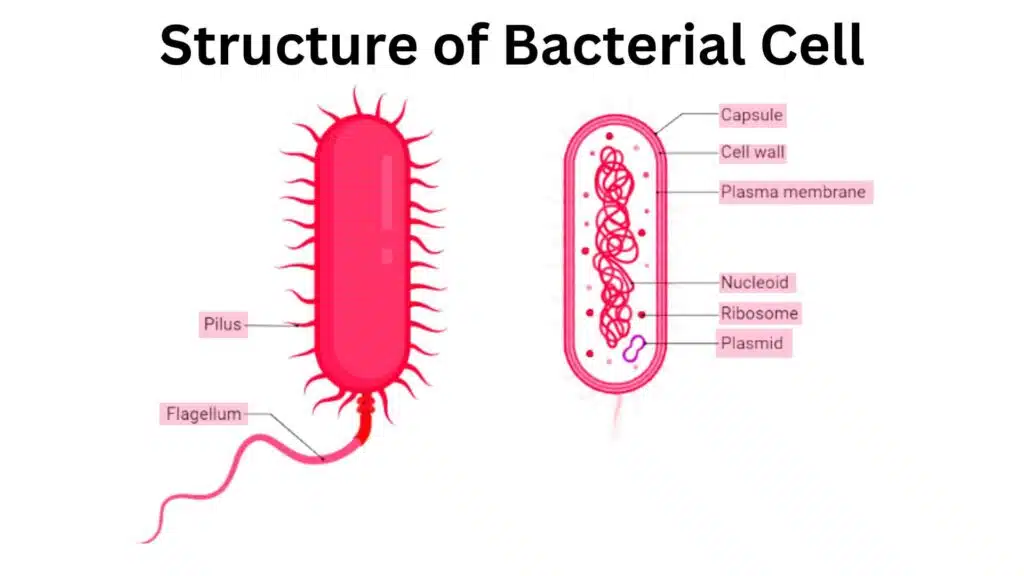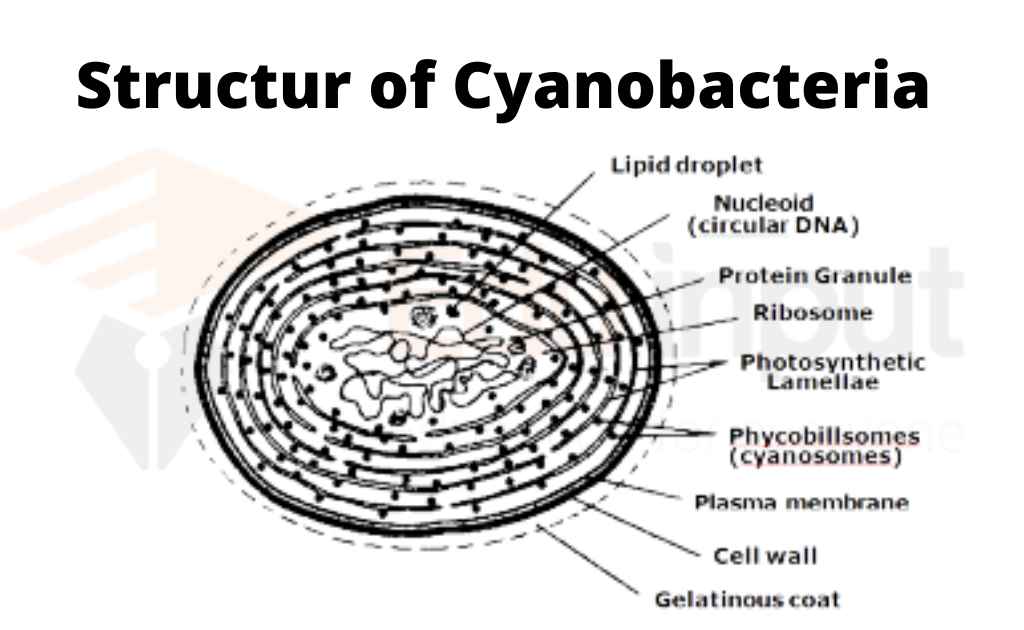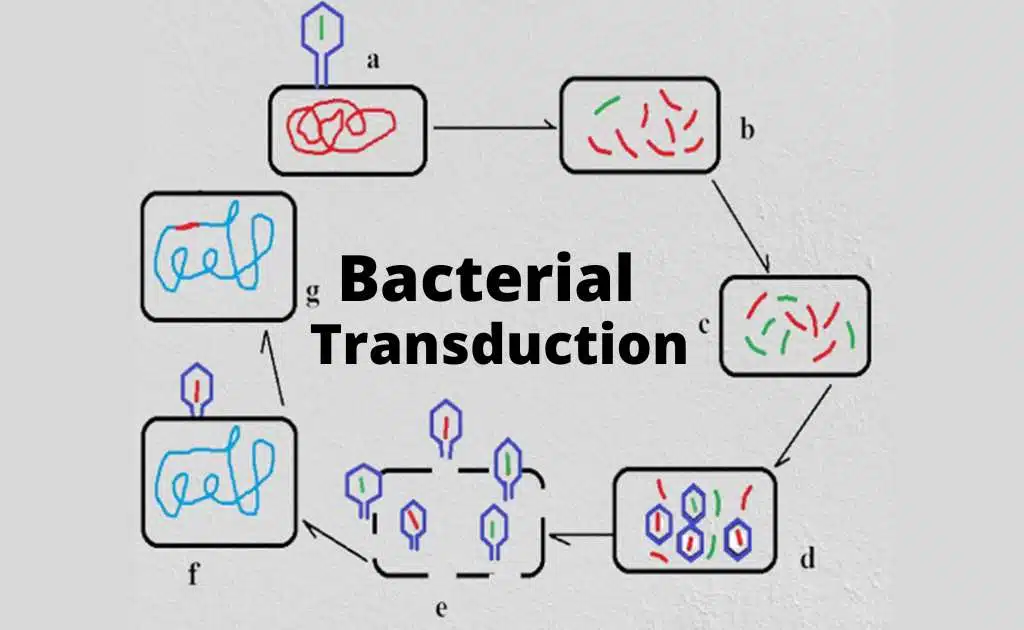Structure of Bacterial Cell
The structure of bacterial cell consists of a cell wall, plasma membrane, cytoplasm, ribosomes, and genetic material in the form of circular DNA. Bacteria are a type of microorganism that are typically unicellular and can be found in a wide range of environments, including soil, water, and living organisms. They are diverse in terms of their shape, size, metabolism, and genetic makeup.

Key Points
- Bacteria are unicellular microorganisms found in diverse environments (soil, water, living organisms)
- Cell envelope composed of capsule, slime layer, and cell wall (stickiness, pathogenicity, shape and protection)
- Cell membrane regulates molecule transport and contains metabolic enzymes
- Cytoplasmic matrix contains genetic material and other structures
- Nucleoid holds genetic information and bacteria may contain plasmids
- Ribosomes in cytoplasm make proteins, mesosomes involved in DNA replication, division, enzyme export
- Some bacteria can produce dormant cysts to resist adverse conditions and grow under favorable ones.
Structure of Bacterial Cell
Bacterial cell structure is simple. It shows simple biological organization. It consists of the following components:
The Cell Envelope
Bacterial surfaces and walls are very diverse. Complexes of layers, external to the cell protoplasm are called cell envelopes. The cell envelope includes a capsule, slime, and cell wall.
There is a layer called S-layer. It is found on the surface of prokaryotic cell envelops. It shows a repeating pattern of proteins like a crystal. It is made up of protein monomers and glycoprotein subunits. [1]
Capsule
Some bacteria produce capsules. A capsule is made up of repeating units of polysaccharides or proteins. The capsule is tightly bound to the cell wall. It is thick and gummy. It gives sticky characters to colonies of encapsulated bacteria.
The wet-film India-ink method is effective to visualize bacterial capsules and slime. Mixing ink with a colony or deposit and placing it on a glass slide with a cover-glass results in clear capsules against a dark background. Microscopic observations using oil immersion showed that some strains of Bacterium aerogenes and Bacterium coli formed capsules, while others formed loose slime or neither. The swelling of pneumococci in antiserum was due to visibility, not actual enlargement. [2]
Slime
Some bacteria are covered with a loose, soluble shield of macromolecules called slime capsules. Slime provides greater pathogenicity to bacteria. It protects the bacteria against phagocytosis.
Cell Wall
The cell wall is a rigid structure that surrounds the outside of the cell and is external to the cytoplasmic membrane. It plays an important role in determining the shape of the bacteria and protecting the cells from osmotic lysis. However, not all bacteria have a cell wall, such as the Mycoplasma species.
The main component of the cell wall is a unique macromolecule called peptidoglycan, which is composed of a long framework of glycan (glucose) chains linked with peptide fragments. The amount of peptidoglycan can vary in different types of bacteria. In addition to peptidoglycan, the cell wall also contains other molecules such as sugar, teichoic acid, lipoproteins, and lipopolysaccharides.
The cell wall structure is different in different types of bacteria. For example, gram-positive and gram-negative bacteria have different compositions of cell wall. Some bacteria, like archaea, have unique cell wall structures that differ from those of Eubacteria.
Cell Membrane
The cell membrane, also known as the plasma membrane, is a thin and flexible barrier that surrounds the inside of the cell. It is made up of different types of molecules, like lipids and proteins, and it has different functions depending on the type of cell. In bacteria, the cell membrane is different from the cell membrane in other types of cells called eukaryotes, because it lacks certain types of molecules called sterols.
The cell membrane has several important functions, including regulating the transport of different molecules, like proteins, nutrients, sugar, and electrolytes, in and out of the cell. It also contains enzymes that are important for the cell’s metabolism.
Cytoplasmic Matrix
Inside the cell, there is a substance called the cytoplasmic matrix, which is a gel-like substance that surrounds the cell’s genetic material and other important structures like the nucleoid, ribosomes, and mesosomes. The cytoplasmic matrix is a major part of the cell and small molecules can move through it rapidly.
Nucleoid
The nucleoid is the dense body of genetic material or DNA, that is located near the center of the bacterial cell. It is composed of a single, circular, double-stranded DNA molecule and it is responsible for the cell’s genetic information. Bacteria have only one chromosome and it is called haploid.
Plasmids
Plasmids are circular, double-stranded extra chromosomal DNA molecules in bacteria. They are not essential for bacterial growth and metabolism but they play a role in resistance to drugs and heavy metals, disease and insect resistance, and can be used as vectors for transferring genes in modern genetic engineering.
Ribosomes
Ribosomes are tiny structures composed of RNA and protein that are responsible for making proteins. They are scattered throughout the cytoplasm and are found in high numbers in healthy growing cells.
Mesosomes
Mesosomes are small invaginations of the cell membrane that play a role in DNA replication and cell division and also in the export of exocellular enzymes and respiratory enzymes.
Granules Or Storage Bodies
Some bacteria can store extra nutrients when possible, and these storage materials can be found in granules or storage bodies. These granules can contain glycogen, sulfur, fat, or phosphate. The cell also contains waste material, which is excreted later on, like alcohol, lactic acid, and acetic acid.
Spores
Some bacteria can produce spores, which are metabolically dormant structures with thick walls that can resist adverse environmental conditions like light, high temperature, desiccation, and chemical agents. They can grow under favorable conditions and form new vegetative cells.
Cysts
Cysts are also dormant structures that are thick-walled and desiccation-resistant, that develop during differentiation of vegetative cells and germinate only under suitable conditions.
The studies have found three types of resting stages formed by methane-utilizing bacteria, including an exospore and two types of cysts. The exospores had similar properties to endospores and the cysts were either desiccation-resistant like those of Azotobacter species or differed in structure and were referred to as “Tipid’ cysts.” [3]
Latest Research About Bacterial Structure
- Scientists have analyzed the genome of a new species of Alicyclobacillus, named Alicyclobacillus chiapanensis PA2T, isolated from a crater lake in an active volcano. The genome of A. chiapanensis PA2T contains “extra” genes associated with adaptations to extreme environments, including genes involved in cell wall formation and metabolism for protection in inhospitable conditions. [3]
- Scientists studied the Regulator of Capsule Synthesis (Rcs) stress response in bacteria to understand how it transduces stress signals across the cell envelope to regulate gene expression. They used a site-saturated mutant library of rcsF to identify the region of RcsF that is critical for signal transduction and found that conformational changes in the RcsF/OMP complex mediate signal transduction to the negative regulator IgaA, providing the first direct evidence of the regulatory role of OMPs in Rcs signaling. [4]
- Nanosurfaces combining bactericidal and bacteria-releasing properties are designed using a polystyrene-block-poly(methyl methacrylate) diblock copolymer and titanium oxide coating. Mechanisms of action are investigated using molecular dynamics simulations. [5]
Frequently Asked Questions-FAQs
What is the structure of a bacterial cell?
Bacterial cell consists of:
Cell envelop (capsule. slime)
Cell wall
Cell membrane
Cytoplasmic matrix
Ribosomes
Enzymes
Mesosomes
What are the main characteristics of bacterial cell?
Bacteria are unicellular, prokaryotic and microscopic organisms that lack a defined nucleus.
Do bacteria have DNA?
Yes, Bacteria have genome in form of Nucloid. They have a single, circular chromosome as their genetic material, and this chromosome is haploid.
Do bacteria have mitochondria?
NO, Bacteria do not have mitochondria, as it is prokaryotic organisms that lack membrane bound organelles like mitochondria and chloroplasts.







Leave a Reply